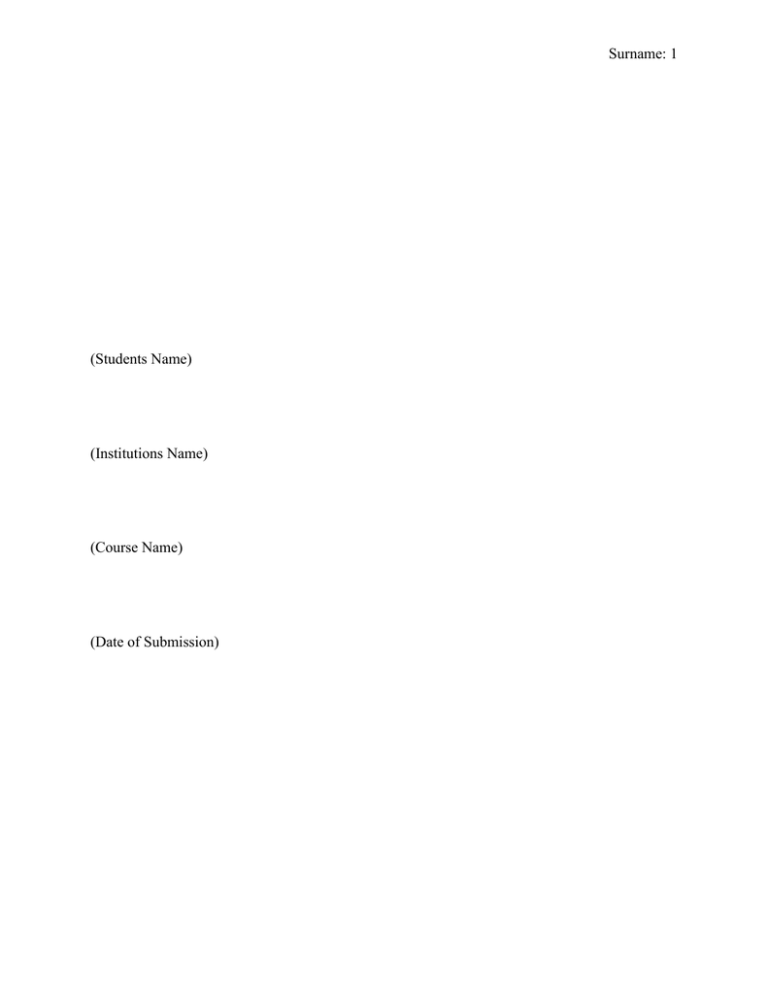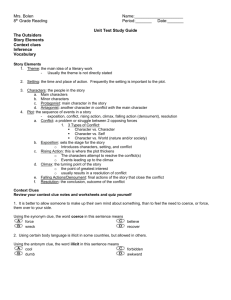Anne Sexton - Homework Market
advertisement

Surname: 1 (Students Name) (Institutions Name) (Course Name) (Date of Submission) Surname: 2 Anne Sexton Anne Sexton was born in 1928, the lastborn in her family, in Newton, Massachusetts. She was the third after her two older sisters. Most of her childhood was spent in Boston. She got her education in Wellesley public schools. When she was 17, she enrolled for boarding school and graduated from Roger Hall Lowell, Massachusetts. She later spent a year at Garland School, a finishing school for women. She modeled for Boston’s Hart Agency. In 1948, she eloped with Alfred Muller Sexton, and married in North Carolina, and remained married to until their divorce on 1973. She had two children, both girls. Anne gave birth to their second child in 1955, and she could not cope with the pressure two small kids with the absence of his husband due to his nature of work. The following year, Anne was hospitalized for treatment of anxiety. She was treated by psychiatrist Dr. Martha Brunner-Orne, diagnosing her with post-natal depression. The psychiatrist later said that Anne suffered from depression of biological nature. Six months later, Anne was treated under the care of Dr. Martin Orne, who took over from the mother (Wood 12-14) It is when receiving psychiatric treatment that she started writing poetry. Dr. Orne encouraged Anne to take up poetry. Driven by her state of mind, illness and depression Anne sort poetry. It was after her suicide attempt that her doctor told her she still had a purpose in life. In 1957, she attended her first poetry led by John Holmes. She joined the John Holmes’s poetry workshop at Boston center for adult education. It is in this workshop that she established friendships with Maxine Kumin. She started writing poetry while still receiving psychiatric treatment. She wrote a number of poems and Surname: 3 several were accepted by publishing medias like Saturday Review and The New Yorker. Her writing was highly influenced by W.D Snodgrass who she met at when she got a scholarship to Antioch Writers’ Conference in 1958. Having read his poem “Heart’s Needle”, she got the motivation and inspiration especially since she had been separated from her daughter. She wrote a poem “The Double Image” that explores the multi-generational relationships between a mother and a daughter. She began attending Robert Lowell’s writing seminars at Boston University. In these seminars, she met and studied with poets George Starbucks and Sylvia Plath. Through her established friendship with Kumin, they wrote four children’s books. (Hume) Anne wrote huge amounts of poetry that were published in dozen poetry books. In 1960, the “To Bedlam and Part Way back” poetry collection was nominated for National Book award. In 1961, she began writing play. Her poetry collection “All My Pretty Ones” was published in 1062 and nominated for the National book award. In the same year, she received Levinson Prize from Poetry. In 1965, she was elected a Fellow of the Royal Society of Literature in London. In the same year, she received the first literary magazine travel award from the International Congress of Cultural Freedom. In 1967, she was awarded the Pulitzer Prize for her poetry work in “Live or Die”. She also received the Shelly award from the Poetry society of America. Anne received awards and nominations on her outstanding poetry work. In addition to the poetry work, she participated in teaching. In 1969, she began teaching at Boston University and also conducting workshops for the Oberlin College Independent Study Students. She was later Surname: 4 promoted to a full professor in 1972 at Boston University. She received grants from the Ford Foundation and two honorary degrees (Hall) Anne’s poetry received criticism on the basis that it is autobiography and it made it hard to distinguish between art and reality. Some of her teachers and readers felt that her poetry was too private. Some readers claimed that her personal subject matter and anatomically accurate language caused discomfort. John Holmes discouraged her from using her private imagery and explicit language. His view on poetic tradition was classical and restrained. At this time, 1972, she divorced her husband and a desperate kind of loneliness took over her life. There were speculations on her extra relations, which have brought many controversies. Anne’s addiction to pills and alcohol worsened during this period. It is said that on the day of her death, 1974, she met with Kumin to discuss galleys for her work that was scheduled for publication later. On returning back home, she committed suicide in her garage by locking herself in her car died of carbon monoxide poisoning. Like any other confessional poet, Anne in her work offers the reader an intimate overview of the emotional distress that characterized her life. In her poetry, she makes being a woman the central issue and brings out subjects like drug addiction, abortion and menstruation to her work. These issues bring controversy and criticism over her work. (Diana) Anne’s work received criticism on the action she took of suicide. The critic says that Anne dealt with suicide and death in all her books. Her last publication “The Death Notebooks” and the next book “The Awful Rowing toward God” were a reflection of what she did. The critic Surname: 5 further says that Anne Sexton is not one of the poets that will be known or understood in times to come. (Sexton) Some people including poets were embarrassed by the naked and painful work of her poetry and they even sort to defame it as it exposed the hypocrisy they live in. The critic rather speaks of Anne’s greatness as a person but not her greatness as a poet. He says the seven publications of the poems by Anne will be understood not as women’s poetry or confessional poetry but as myths that expands human consciousness. The critic says that Anne relied on myths to write in her poem “Live or Die” and derives that Anne makes mythological proclamations throughout the poem. Other respective critics have criticized her work towards the end of the sixties as “preening, lazy and flip” (McClatchy). Others regard her dependence on alcohol as compromising on her work. Critics suggest that her poetry appears to be directly correlated with her dark life and that there are lines in her poems that can be directly traced back to her life experiences. The work of her poetry is at as reinvented myth or a myth that is written from a female perceptive. Some critics feel that Anne’s work purposely driven by her dire need for attention in her familial and social relations. Some feel that she was that wry enough to manipulate her poetry so as to combine lies and myth with the aspect of her health condition to attract attention. They justify this by saying that by reading her poem, one can tell of all the events of her life; an abusive father, scarring accident at a young age, birth of two daughter, death of friends, death of the parents, her stay in a mental institution and finally her search for release through drugs, lovers, religion. Surname: 6 Works Cited Diana, Hume George. Sexton: Selected Criticism. Urbana,111: University of Illinois Press, 1988. 142-43 Hall, Caroline King Barnard. Anne Sexton. Boston: Twayne Publishers, 1989. 23-25 Hume, George Diana. Oedipus Anne: The Poetry of Anne Sexton. Urbana: University of Illinois Press, 1987.101-02 McClatchy, J.D. Anne Sexton: the Artist and Her Critics. Indiana Univ Pr, 1978. 77-78 Sexton, Anne. The Complete Poems. Boston : Houghton Mifflin company, 1981. Wood, Middlebrook Diane. Anne Sexton: A Biography. Boston: Vintage, 1992.36-39 Surname: 7 Surname: 8


